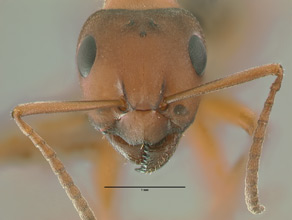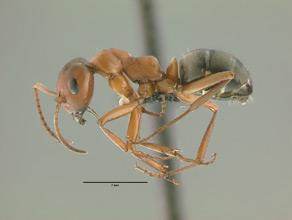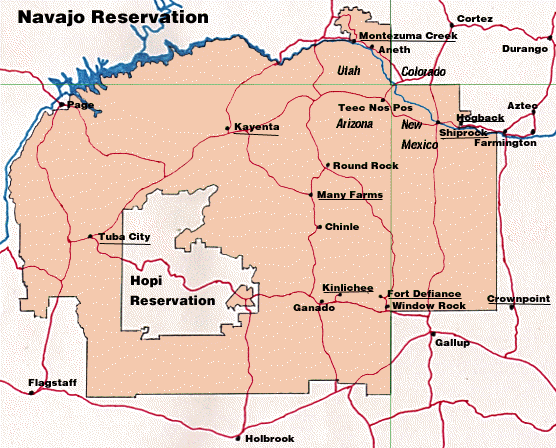- Identification
- Medium-sized bicolored workers (darker brown gaster with lighter colored, yellowish-red alitrunk and head) with dense gastric pubescence. Formica gynocrates belong to the sanguinea species group, which are behaviorally differentiated from other Formica species by their slavemaking habitats. Morphologically the combination of dense gastric pubescence and an indentation in the middle of the clypeus or, more technically, a median concave impression on the anterior border of the clypeus set them apart from other North American Formica.
- Biology
- A facultative slavemaking ant that exploits and parasitize Formica species from the neogagates species group. Formica gynocrates nest in open sites that have fairly well exposed ground. In their type locality (see below) they strongly favored parasitizing Formica vinculans colonies, which is also an open habitat ant species. Mating flights occur from early July to mid August, during early to mid morning (after sunrise).
- additional biology notes...
- Distribution
- Range
- Northern U.S. Known from North Dakota, Michigan, Wyoming and Colorado.
- Navajo Reservation Records
- Specimens being processed.
- Additional Notes
- The sanguinea species group are ants that parasitize and enslave other Formica species. Most of the species are believed to be facultative and not obligate slave makers. The raiding ants often restrict their attention to specific Formica subgroups (e.g. the fusca, neoformica or neogagates species group) but, at least for wider ranging forms, do not appear to specialize on any single Formica species. All the sanguinea species are dependent upon parasitizing a foreign host species for starting new nests; newly mated queens must enter the nest of another Formica species, kill the queen, and be adopted by the workers in order to succeed in founding a new nest.
- Nesting Biology
- Modifed from Talbot (1985):
Formica gynocrates have a tendency to leave a covering of soil near their nest openings. This may occur after rains and especially during flight periods when a vague circle may reach 30-60 cm in diameter. This does not mark the limits of the nest as alates may emerge from other openings in the grass beyond. Mixed nests may also create small piles of debris (e.g. sand grains, tiny pebbles , leaf scales , and bits of dead leaves , lichen , and moss) around the bases of plants on or near the nest. These structures may be 2.5 - 7 .5 cm across and enclose aphids. They may also serve as aboveground chambers for incubating pupae and mature alates.
- Nest relocation can occur at any time. Colonies typically do not move far, potentially just a few meters, and generally take more than a week to complete. The process is a steady back and forth movement of workers and brood between the under-construction, new nest and the old soon-to-be abandoned old nest.
- Raiding Behavior
- Talbot (1985) provided an excellent accounting of the raiding behavior...
Raids might start at any time of day from 0645 to 1645. They were most frequent in early to mid-morning and when the day began to cool in the afternoon, but sometimes started at mid-day if temperatures were not too high. The ants seemed not as sensitive to heat as the other sanguinea group species on the Reserve, and were not so apt to have a mid-day lull.
The beginning of a raid was not an especially clear-cut activity. Workers would become more numerous on the nest and then a little group would start off on one of the trails. At first they traveled close together but soon would spread out as individuals wandered back and forth and from side to side, exploring the terrain. As workers moved farther apart the line would become indistinct. Usually other groups left the nest at intervals, followed the first, and extended the line. If any workers found what seemed to be a Formica vinculans nest others would gather, searching very carefully for openings. If they failed to find a colony quickly some continued to hunt at that place while others would either increase the area of search, move forward, or start back home. Colonies were sometimes easy to find because entrances were obvious; others were so thoroughly concealed and blocked that considerable searching and digging was necessary.
Formica vinculans had a characteristic habit when attacked. Some workers rushed out carrying brood up nearby plant stems so that sometimes they were a conspicuous sight, a whole area of grass covered with dozens of workers, each holding a pupa or, more rarely, a larva. Usually the attacking ants did not pursue them but waited until they came down and then took their brood.
Some Formica vinculans colonies staged a good defense of the nest, either above-ground or down in the nest. Sometimes no defense was attempted; perhaps these colonies had been raided before, possibly several times.
On the morning of 13 July 1973, one Formica gynocrates colony raided three nests . The first two did not resist but the third did. The first raid began at 0744. By this time many workers were on the home nest and were starting to wander off along a trail. Out in denser grasses the line became sparse and wide, then dwindled to individual workers and was lost. Other groups went out and by 0815 some had found a nest 22 m away. Then the line became well populated. There was no fighting at the Formica vinculans colony and only a few workers ran up onto grasses holding brood. Almost immediately the raiding ants began to take pupae from the nest, going back over the same trail and meeting others coming out. Very few pupae were found and within 5 min a group began to push uphill, exploring carefully and moving slowly. They found a second colony 3.7 m away in a large clump of dead grass. Here again there was no resistance and brood was carried off for the next 15 min.
A cluster of Formica gynocrates then found a third nest only 1.2 m above the second. This colony was large and belligerent, staging a good defense . Workers rushed out in great numbers and, while some carried brood up slope from the nest, a great many formed a half circle 25 cm below the three main openings. They fought vigorously all along the line and held the Formica gynocrates at bay for 40 min. Fighting involved two or three ants of one species holding an ant of the other species by legs and antennae and stretching it until it died. Sometimes this was unsuccessful and, after tumbling about a bit, the group fell apart without any being hurt . Defenders greatly outnumbered aggressors and. it looked as if they might win, but a large group of Formica gynocrates reinforcements arrived, fighting was accelerated, and the tide of battle turned.
At this time it was noted that certain Formica gynocrates were running forward for short distances among the Formica vinculans and then retreating swiftly. It could not be seen if they were spraying but it seemed possible that they were releasing an intimidating allamone.
Ten minutes later the Formica gynocrates workers had broken through the Formica vinculans line and were moving all over the nest site . They did not find many pupae and half an hour later most had returned home . By this time (1030) ground temperature was 49° and Workers were running fast and keeping up off the ground as much as possible.
Some colonies carried on their defense within the nest instead of on the surface. One such colony had nested in a bed of moss and its entrances were thoroughly concealed. At 1345, 13 July 1973, Formica gynocrates workers were digging into the moss at one place and others were exploring for 0.3-1. 2 m in all directions. Evidently the hole they opened led to a nest, for soon a the Formica vinculans worker was dragged out and stretched by two Formica gynocrates. Then several more were extracted. A half hour later the raiding workers were still trying to penetrate farther into this entrance and had made another hole 10 cm away from which they pulled an occasional worker. After another 40 min they began pouring out with brood. Evidently the defense had broken down. At this time there were about 50 Formica gynocrates at the nest, more were traveling to it, and brood was being carried off at a rate of 6.6/min. By 1555 230 pupae and 89 larvae had been captured. As the stream of pupae dwindled some ants spread out seeking dead the Formica vinculans workers, which they carried home, and four discarded Formica gynocrates workers were found.
Not all of the raids were successful. Sometimes exploratory groups started out on a trail, branched from it, and spread out searching, but failed to find a colony. In these cases workers gradually returned home along the trail. - Etymology
- Behavioral. The specific name combines the Greek gyne (woman) and krateo (rule), in reference to the dulotic habits of this species.

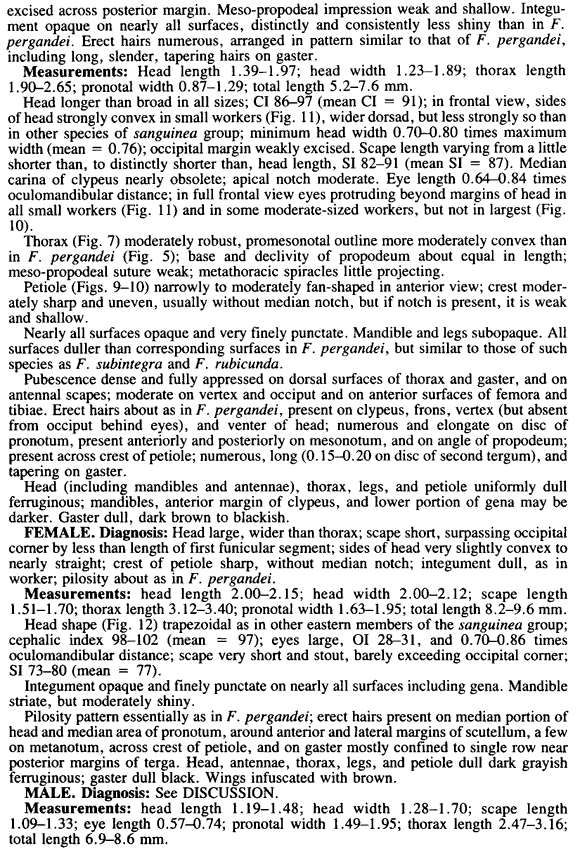

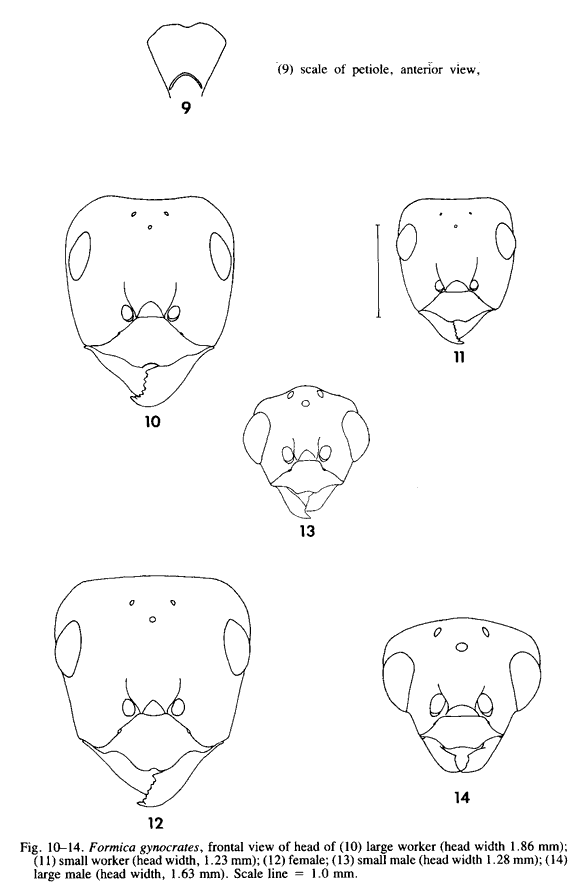
- Literature
- Snelling, R. R. and W. F. Buren. 1985. Description of a new species of slave-making ant in the Formica sanguinea group (Hymenoptera: Formicidae). Great Lakes Entomologist. 18:69-78.
- Talbot, M. 1985. The slave-making ant Formica gynocrates (Hymenoptera: Formicidae). Great Lakes Entomologist. 18:103-112.
- A note about these publications. The literature cited here is not meant to be an exhaustive list of papers published about this species.
Page authored by David Lubertazzi and Gary Alpert
